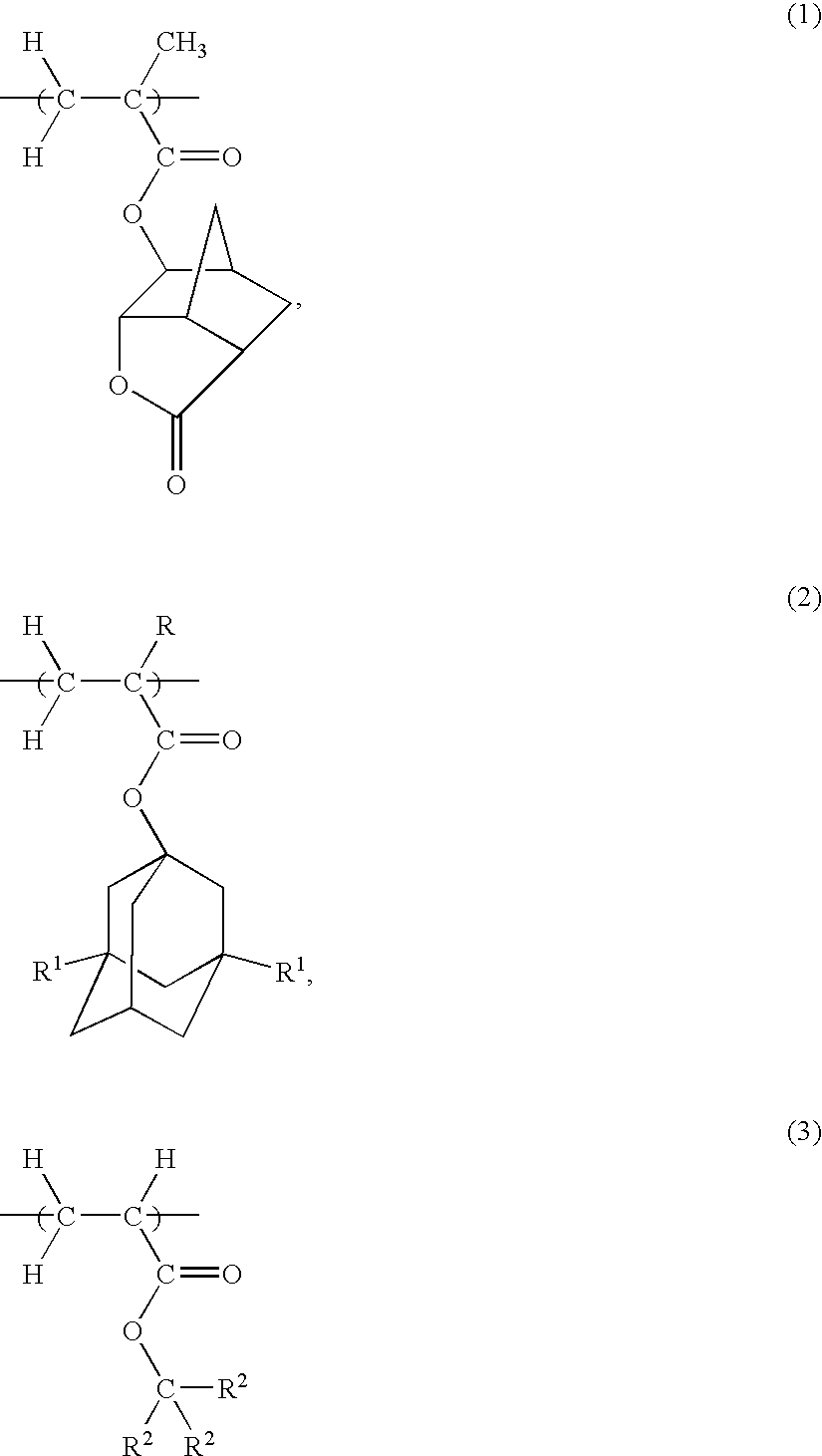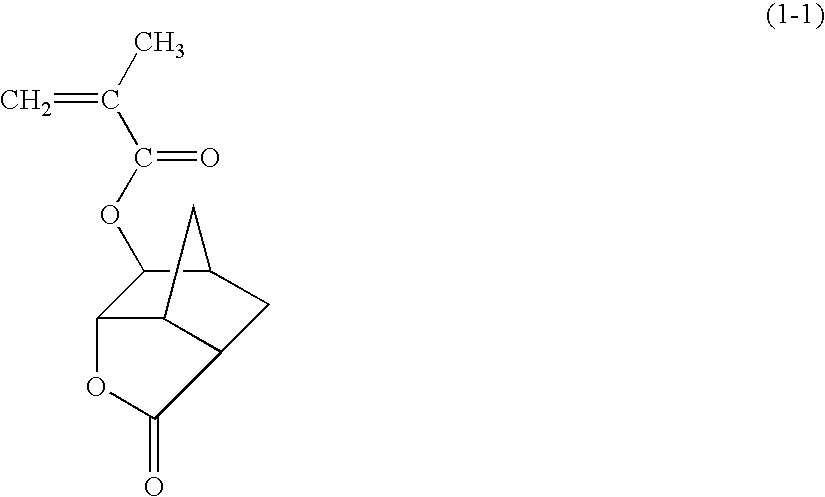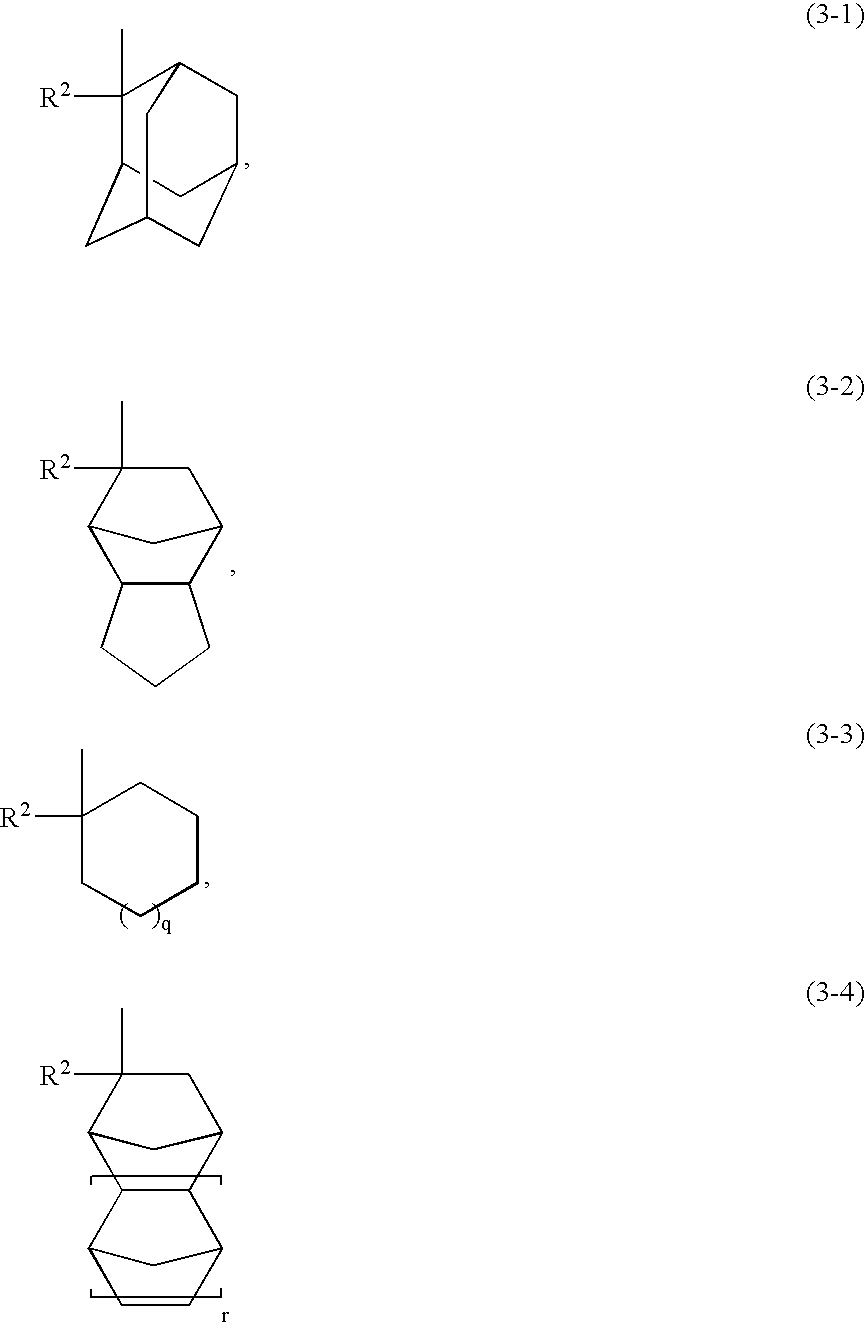Acrylic copolymer and radiation-sensitive resin composition
a technology of radiation-sensitive resin and copolymer, which is applied in the direction of photosensitive materials, instruments, photomechanical equipment, etc., can solve the problems of no radiation-sensitive resin composition and adverse etching operation, and achieve excellent heat treatment temperature dependence, excellent patterns in the formation of lines-and-spaces and contact holes, and wide process margin
- Summary
- Abstract
- Description
- Claims
- Application Information
AI Technical Summary
Benefits of technology
Problems solved by technology
Method used
Image
Examples
example 1
[0251]
[0252]A monomer solution was prepared by dissolving 55.00 g (50 mol %) of compound (4-1), 11.70 g (10 mol %) of compound (4-2), and 33.31 g (40 mol %) of compound (4-3) in 200 g of 2-butanone, and further adding 4.56 g of dimethyl azobisisobutyrate. A 1000 ml three-necked flask was charged with 100 g of 2-butanone and nitrogen gas was purged into the flask for 30 minutes. After nitrogen purge, the flask was heated to 80° C. while stirring and the above monomer solution was added dropwise using a dropping funnel over four hours. The polymerization reaction was carried out for six hours after initiation of dropping. After completion of polymerization, the polymer solution was cooled with water to 30° C. or lower and poured into 2,000 g of a 1:2 mixed solvent of 2-propanol and n-heptane. White precipitate produced was collected by filtration. The white powder collected by filtration was washed twice with 400 g of a 1:2 mixed solvent of 2-propanol and n-heptane in a slurry state, ...
example 2
[0253]
[0254]A monomer solution was prepared by dissolving 54.57 g (50 mol %) of compound (5-1), 12.39 g (10 mol %) of compound (5-2), and 33.04 g (40 mol %) of compound (5-3) in 200 g of 2-butanone, and further adding 4.52 g of dimethyl azobisisobutyrate. A 1000 ml three-necked flask was charged with 100 g of 2-butanone and nitrogen gas was purged into the flask for 30 minutes. After nitrogen purge, the flask was heated to 80° C. while stirring and the above monomer solution was added dropwise using a dropping funnel over four hours. The polymerization reaction was carried out for six hours after initiation of dropping. After completion of polymerization, the polymer solution was cooled with water to 30° C. or lower and poured into 2,000 g of a 1:2 mixed solvent of[0255]2-propanol and n-heptane. White precipitate produced was collected by filtration. The white powder collected by filtration was washed twice with 400 g of a 1:2 mixed solvent of 2-propanol and n-heptane in a slurry st...
example 3
[0256]
[0257]A monomer solution was prepared by dissolving 55.38 g (50 mol %) of compound (6-1), 11.08 g (10 mol %) of compound (6-2), and 33.54 g (40 mol %) of compound (6-3) in 200 g of 2-butanone, and further adding 4.59 g of dimethyl azobisisobutyrate. A 1000 ml three-necked flask was charged with 100 g of[0258]2-butanone and nitrogen gas was purged into the flask for 30 minutes. After nitrogen purge, the flask was heated to 80° C. while stirring and the above monomer solution was added dropwise using a dropping funnel over four hours. The polymerization reaction was carried out for six hours after initiation of dropping. After completion of polymerization, the polymer solution was cooled with water to 30° C. or lower and poured into 2,000 g of a 1:2 mixed solvent of[0259]2-propanol and n-heptane. White precipitate produced was collected by filtration. The white powder collected by filtration was washed twice with 400 g of a 1:2 mixed solvent of 2-propanol and n-heptane in a slur...
PUM
| Property | Measurement | Unit |
|---|---|---|
| width | aaaaa | aaaaa |
| width | aaaaa | aaaaa |
| width | aaaaa | aaaaa |
Abstract
Description
Claims
Application Information
 Login to View More
Login to View More - R&D
- Intellectual Property
- Life Sciences
- Materials
- Tech Scout
- Unparalleled Data Quality
- Higher Quality Content
- 60% Fewer Hallucinations
Browse by: Latest US Patents, China's latest patents, Technical Efficacy Thesaurus, Application Domain, Technology Topic, Popular Technical Reports.
© 2025 PatSnap. All rights reserved.Legal|Privacy policy|Modern Slavery Act Transparency Statement|Sitemap|About US| Contact US: help@patsnap.com



